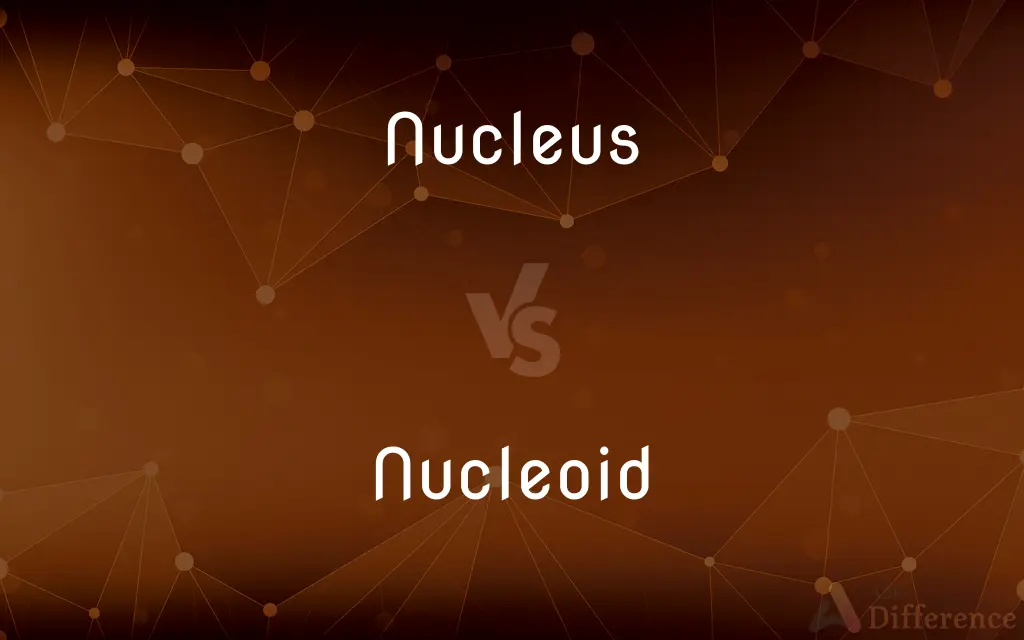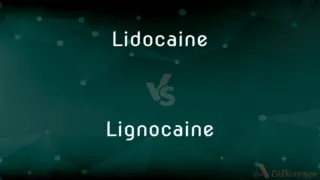Nucleus vs. Nucleoid — What's the Difference?
By Tayyaba Rehman — Updated on September 20, 2023
The nucleus is a membrane-bound structure in eukaryotic cells containing DNA. The nucleoid is an irregularly shaped region in prokaryotic cells that also contains DNA but is not enclosed by a membrane.

Difference Between Nucleus and Nucleoid
Table of Contents
ADVERTISEMENT
Key Differences
The nucleus and nucleoid are both cellular regions where genetic material is stored. However, the nucleus is a well-defined, membrane-bound organelle found in eukaryotic cells. The nucleoid, on the other hand, is an area in prokaryotic cells, and it lacks a membrane.
Both the nucleus and nucleoid are crucial for cell function and reproduction. The nucleus often contains multiple chromosomes made of DNA and proteins, while the nucleoid consists of a single, circular chromosome. Eukaryotic cells can have more than one nucleus, but prokaryotic cells typically contain a single nucleoid.
In terms of complexity, the nucleus is more complex than the nucleoid. It's surrounded by a double membrane called the nuclear envelope and contains various sub-structures like nucleoli. The nucleoid is simpler; it's just a concentrated mass of DNA without such complex features.
Functionally, the nucleus serves as the cell's control center, regulating gene expression and facilitating DNA replication and repair. The nucleoid, while less complex, performs similar functions but in a more streamlined manner due to the lack of membrane and sub-structures.
Comparison Chart
Cell Type
Eukaryotic
Prokaryotic
ADVERTISEMENT
Membrane
Membrane-bound
Not enclosed
Complexity
More complex
Simpler
Chromosomes
Multiple
Usually single
Sub-structures
Nucleoli, etc.
None
Compare with Definitions
Nucleus
The central core of an atom.
The nucleus of an atom contains protons and neutrons.
Nucleoid
A region that contains the single, circular chromosome in bacteria.
The nucleoid organizes the bacterial DNA.
Nucleus
A principal point or place where something originates or accumulates.
The city is the nucleus of cultural activity.
Nucleoid
A compact structure containing the genetic material in some algae and fungi.
The nucleoid in blue-green algae is simple.
Nucleus
A cluster of neurons in the central nervous system.
The nucleus accumbens is involved in reward processing.
Nucleoid
An area in prokaryotic cells where DNA is concentrated.
The nucleoid is not enclosed by a membrane.
Nucleus
A central or essential part around which other parts are gathered or grouped; a core
The nucleus of a city.
Nucleoid
The space where DNA is found in Archaea.
The archaeal nucleoid is similar to that of bacteria.
Nucleus
Something regarded as a basis for future development and growth; a kernel
A few paintings that formed the nucleus of a great art collection.
Nucleoid
The DNA-containing area of a prokaryotic cell.
The nucleoid is crucial for bacterial reproduction.
Nucleus
(Biology) A membrane-bound organelle within a eukaryotic cell that contains most of the cell's genetic material. DNA transcription takes place in the nucleus.
Nucleoid
The nucleoid (meaning nucleus-like) is an irregularly shaped region within the prokaryotic cell that contains all or most of the genetic material. The chromosome of a prokaryote is circular, and its length is very large compared to the cell dimensions needing it to be compacted in order to fit.
Nucleus
(Anatomy) A group of specialized nerve cells or a localized mass of gray matter in the brain or spinal cord.
Nucleoid
The undefined region of genetic material inside a prokaryotic cell, consisting of aggregated DNA.
Nucleus
(Physics) The positively charged central region of an atom, composed of protons and neutrons, about which negatively charged electrons orbit. Extremely small and dense, the nucleus contains almost all of the mass of an atom.
Nucleoid
(microbiology) The irregularly-shaped region within a prokaryote cell where the genetic material is localized
Nucleus
(Chemistry) A group of atoms bound in a structure, such as a benzene ring, that is resistant to alteration in chemical reactions.
Nucleus
The central, often brightest part of the head of a comet.
Nucleus
The solid part of a comet, composed of ice and smaller amounts of dust and rock.
Nucleus
The central, often brightest part of a galaxy.
Nucleus
(Meteorology) A particle on which water vapor molecules accumulate in free air to form a droplet or ice crystal.
Nucleus
(Linguistics) The part of a syllable having the greatest sonority. In the word middlemost (mĭdl-mōst′) the nuclei of the three syllables are (ĭ), (l), and (ō); in the Czech word krk ("neck"), the nucleus is (r).
Nucleus
The core, central part of something, around which other elements are assembled.
Nucleus
An initial part or version that will receive additions.
This collection will form the nucleus of a new library.
Nucleus
The massive, positively charged central part of an atom, made up of protons and neutrons. Category:en:Nuclear physics
Nucleus
(cytology) A large membrane-enclosed organelle found in eukaryotic cells which contains genetic material.
Nucleus
(neuroanatomy) A ganglion, cluster of many neuronal bodies where synapsing occurs.
Nucleus
The central part of a syllable, most commonly a vowel.
Nucleus
A kernel; hence, a central mass or point about which matter is gathered, or to which accretion is made; the central or material portion; - used both literally and figuratively.
It must contain within itself a nucleus of truth.
Nucleus
The body or the head of a comet.
Nucleus
An incipient ovule of soft cellular tissue.
Nucleus
A body, usually spheroidal, in a eukaryotic cell, distinguished from the surrounding protoplasm by a difference in refrangibility and in behavior towards chemical reagents, which contains the chromosomal genetic material, including the chromosomal DNA. It is more or less protoplasmic, and consists of a clear fluid (achromatin) through which extends a network of fibers (chromatin) in which may be suspended a second rounded body, the nucleolus (see Nucleoplasm). See Cell division, under Division.
Nucleus
The tip, or earliest part, of a univalve or bivalve shell.
Nucleus
A part of the cell containing DNA and RNA and responsible for growth and reproduction
Nucleus
The positively charged dense center of an atom
Nucleus
A small group of indispensable persons or things;
Five periodicals make up the core of their publishing program
Nucleus
(astronomy) the center of the head of a comet; consists of small solid particles of ice and frozen gas that vaporizes on approaching the sun to form the coma and tail
Nucleus
Any histologically identifiable mass of neural cell bodies in the brain or spinal cord
Nucleus
A membrane-bound organelle in eukaryotic cells that contains DNA.
The nucleus is the control center of a cell.
Nucleus
The primary or most important part of a whole.
The nucleus of the team is its star player.
Common Curiosities
Is the Nucleus present in all cells?
No, the nucleus is present only in eukaryotic cells.
What is a Nucleus?
A nucleus is a membrane-bound organelle in eukaryotic cells that contains DNA.
Do bacterial cells have a Nucleoid?
Yes, bacterial cells contain a nucleoid.
Can a cell have multiple Nuclei?
Yes, some eukaryotic cells can have multiple nuclei.
What is the role of the Nucleus?
It controls gene expression and houses genetic material.
Is the Nucleoid membrane-bound?
No, the nucleoid is not enclosed by a membrane.
What's inside the Nucleus?
The nucleus contains DNA, RNA, and proteins.
What is the nuclear envelope?
It's the double membrane surrounding the nucleus.
What is a Nucleoid?
A nucleoid is an area in prokaryotic cells where DNA is concentrated, but not membrane-bound.
What's inside the Nucleoid?
The nucleoid contains a single, usually circular, chromosome.
Do plant cells have a Nucleus?
Yes, plant cells have a nucleus.
Can a cell have multiple Nucleoids?
Typically, prokaryotic cells have a single nucleoid.
Is the Nucleoid complex?
No, it is simpler compared to the nucleus.
Share Your Discovery

Previous Comparison
Leftover vs. Leftovers
Next Comparison
Lidocaine vs. LignocaineAuthor Spotlight
Written by
Tayyaba RehmanTayyaba Rehman is a distinguished writer, currently serving as a primary contributor to askdifference.com. As a researcher in semantics and etymology, Tayyaba's passion for the complexity of languages and their distinctions has found a perfect home on the platform. Tayyaba delves into the intricacies of language, distinguishing between commonly confused words and phrases, thereby providing clarity for readers worldwide.














































